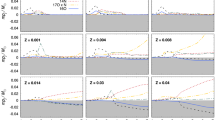Abstract
The study of the chemical composition of stars and galaxies is a key topic for understanding their origin and evolution. In this study, we present the results of the calculation of solar abundances of the isotopes 1H, 4He, 12C, 14N, 15O, 16O, 17O, and 18O during the four phases of the solar life: hydrogen burning, onset of rapid growth and red giant, helium burning and helium exhaustion. The open source package “NucNet Tools” from the Webnucleo Group in Clemson University, SC, USA was used for this purpose. The results for all isotopes are listed in tables for future use. Abundances found, globally, agree fairly well with those predicted in the literature. Results obtained for the last two phases have no equivalents elsewhere.
Similar content being viewed by others
References
M. Salaris and S. Cassisi, Evolution of Stars and Stellar Populations (Wiley, 2006).
H. A. Bethe, Physical Rev. 55, 103 (1939).
E. M. Burbidge, G. R. Burbidge, W. A. Fowler, and F. Hoyle, Rev. Modern Physics 29, 547 (1957).
M. Gargaud, R. Amils, J. C. Quintanilla, et al., Encyclopedia of Astrobiology (Springer-Verlag, Berlin, Heidelberg, 2011).
G. Wallerstein, I. Iben, Jr., P. Parker, et al., Rev. Modern Physics 69, 995 (1997).
B. S. Meyer, L. R. Nittler, A. N. Nguyen, and S. Messenger, Rev.Mineralogy Geochemistry 68, 31 (2008).
K. Lodders, Astrophys. J. 591, 1220 (2003).
H. Yurimoto, K. Kuramoto, A. N. Krot, et al., in Proc. Conf. on Protostars and Planets V, Ed. by V. B. Reipurth, D. Jewitt, and K. Keil (Univ. Arizona Press, Tucson, 2007), pp. 849–862.
K. Lodders, H. Palme, and H.-P. Gail, Landolt–Börnstein—Group VI Astronomy and Astrophysics 4B, 44L (2009).
M. F. El Eid, B. S. Meyer, and L.-S. The, Astrophys. J. 611, 452 (2004).
http://www.astronomy.ohio-state.edu/~pogge/Lectures/vistas97.html
K. S. Krane and W. G. Lynch, Physics Today 42, 78 (1989).
B. Meyer, in Proc. 12th Intern. Symp. on Nuclei in the Cosmos (NIC XII), Cairns, Australia, 2012, http://pos.sissa.it/cgi-bin/reader/conf.cgi?confid=146, id.96.
B. Côté, C. Ritter, F. Herwig, et al., in Proc. 14th Intern. Symp. on Nuclei in the Cosmos (NIC2016), Ed. by S. Kubono, T. Kajino, S. Nishimura, et al. (2017), p. 020203.
Author information
Authors and Affiliations
Corresponding author
Additional information
Published in Russian in Astrofizicheskii Byulleten’, 2018, Vol. 73, No. 2, pp. 244–249.
The text was submitted by the authors in English.
Rights and permissions
About this article
Cite this article
Talafha, M.H., Al-Wardat, M.A. & Ershaidat, N.M. A Study of the Abundance of Low-Z Elements in the Sun During its Whole Predicted Life. Astrophys. Bull. 73, 235–240 (2018). https://doi.org/10.1134/S1990341318020098
Received:
Accepted:
Published:
Issue Date:
DOI: https://doi.org/10.1134/S1990341318020098




